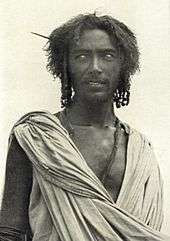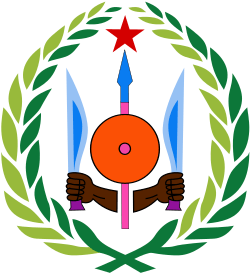Demographics of Djibouti
This article is about the demographics of Djibouti, including population density, ethnicity, education level, health, economic status, religious affiliations and other aspects of the population.
| Demographics of Djibouti | |
|---|---|
| Population | 884,017 (2018) |
| Growth rate | 2.23% (2014) |
| Birth rate | 25.27 births/1,000 population (2011 est.) |
| Death rate | 8.23 deaths/1,000 population (July 2011 est.) |
| Life expectancy | 62.4 years (2014) |
| • male | 59.93 years |
| • female | 64.94 years |
| Fertility rate | 2.79 children born/woman (2010) |
| Infant mortality rate | 53.31 deaths/1,000 infants (2012 est.)[1] |
| Age structure | |
| 0–14 years | 35% (male 132,592/female 132,114) |
| 15–64 years | 61.7% (male 206,323/female 260,772) |
| 65 and over | 3.3% (male 11,349/female 13,924) |
| Sex ratio | |
| At birth | 1.03 male(s)/female |
| Under 15 | 1 male(s)/female |
| 15–64 years | 0.8 male(s)/female |
| 65 and over | 0.81 male(s)/female |
| Nationality | |
| Nationality | Djiboutian |
| Major ethnic | Somali 60% Afar 35% |
| Minor ethnic | French Arab Ethiopian Total 5% |
| Language | |
| Spoken | Arabic (official), French(official), Somali(official), Afar |
Ethnic groups

Djibouti is a multiethnic country. As of 2018, it has a population of around 884,017 inhabitants[2][3]. Djibouti's population grew rapidly during the latter half of the 20th century, increasing from about 69,589 in 1955 to around 869,099 by 2015.[4]
The two largest ethnic groups are the Somali (60%) and the Afar (35%). The Somali clan component is mainly composed of the Issas, a sub-clan of the larger Dir. The remaining 5% of Djibouti's population primarily consists of Arabs, Ethiopians and Europeans (French and Italians). Approximately 76% of local residents are urban dwellers; the remainder are pastoralists.[5] 40,000 people from Yemen live in Djibouti, counting for 4.2% of its total population.[6] 4,000 soldiers from the United States live in Djibouti, they represent 0.4% of its total population.[7]
Languages
Djibouti is a multilingual nation.[5] The majority of local residents speak Somali (524,000 speakers) and Afar (306,000 speakers) as a first language. These idioms are the mother tongues of the Somali and Afar ethnic groups, respectively. Both languages belong to the larger Afroasiatic family. There are three official languages in Djibouti: Somali, Arabic and French.[8]
Arabic is of religious importance. In formal settings, it consists of Modern Standard Arabic. Colloquially, about 59,000 local residents speak the Ta'izzi-Adeni Arabic dialect, also known as Djibouti Arabic. French serves as a statutory national language. It was inherited from the colonial period, and is the primary language of instruction. Around 17,000 Djiboutians speak it as a first language. Immigrant languages include Omani Arabic (38,900 speakers), Amharic (1,400 speakers), Greek (1,000 speakers) and Hindi (600 speakers).[8]
Population
| 1960–2012 | ||
|---|---|---|
| Year | Pop. | ±% p.a. |
| 1960 | 83,636 | — |
| 1969 | 149,887 | +6.70% |
| 1977 | 277,750 | +8.02% |
| 1980 | 359,247 | +8.95% |
| 1994 | 652,793 | +4.36% |
| 2000 | 722,887 | +1.71% |
| 2012 | 859,652 | +1.45% |
| Source: World Bank[9] | ||
According to the 2019 revision of the World Population Prospects[2][3], the total population was 958,923 in 2018 compared to 62,000 in 1950. The proportion of children below the age of 15 in 2010 was 35.8%, 60.9% was between 15 and 65 years of age, while 3.3% was 65 years or older.[4]
| Total population | Population aged 0–14 (%) | Population aged 15–64 (%) | Population aged 65+ (%) | |
|---|---|---|---|---|
| 1950 | 62 000 | 46.8 | 51.2 | 2.0 |
| 1955 | 70 000 | 46.0 | 52.0 | 2.0 |
| 1960 | 85 000 | 45.4 | 52.5 | 2.0 |
| 1965 | 117 000 | 44.9 | 53.0 | 2.0 |
| 1970 | 162 000 | 45.8 | 52.2 | 2.1 |
| 1975 | 224 000 | 45.9 | 52.0 | 2.1 |
| 1980 | 340 000 | 45.3 | 52.5 | 2.2 |
| 1985 | 403 000 | 44.6 | 53.1 | 2.3 |
| 1990 | 562 000 | 44.2 | 53.4 | 2.4 |
| 1995 | 627 000 | 43.4 | 54.1 | 2.5 |
| 2000 | 732 000 | 41.3 | 55.9 | 2.7 |
| 2005 | 808 000 | 38.5 | 58.5 | 3.0 |
| 2010 | 889 000 | 35.8 | 60.9 | 3.3 |
Projections
The following are UN medium variant projections; numbers are in thousands:[4]
- 2015 975
- 2020 1,065
- 2025 1,166
- 2030 1,262
- 2035 1,356
- 2040 1,447
- 2045 1,535
- 2050 1,619
Vital statistics
Registration of vital events in Djibouti is incomplete. The Population Department of the United Nations prepared the following estimates.[4]
| Period | Live births per year | Deaths per year | Natural change per year | CBR* | CDR* | NC* | TFR* | IMR* |
|---|---|---|---|---|---|---|---|---|
| 1950-1955 | 3 000 | 2 000 | 1 000 | 50.0 | 28.3 | 21.7 | 7.80 | 222 |
| 1955-1960 | 4 000 | 2 000 | 2 000 | 50.7 | 25.7 | 25.0 | 7.80 | 203 |
| 1960-1965 | 5 000 | 2 000 | 3 000 | 51.2 | 23.8 | 27.4 | 7.80 | 185 |
| 1965-1970 | 7 000 | 3 000 | 4 000 | 50.3 | 21.6 | 28.6 | 7.60 | 169 |
| 1970-1975 | 9 000 | 4 000 | 5 000 | 47.8 | 19.4 | 28.4 | 7.20 | 154 |
| 1975-1980 | 13 000 | 5 000 | 8 000 | 45.2 | 17.4 | 27.8 | 6.80 | 141 |
| 1980-1985 | 16 000 | 6 000 | 11 000 | 44.0 | 15.5 | 28.6 | 6.60 | 125 |
| 1985-1990 | 21 000 | 7 000 | 14 000 | 43.1 | 14.5 | 28.6 | 6.40 | 117 |
| 1990-1995 | 24 000 | 8 000 | 16 000 | 40.1 | 13.4 | 26.7 | 5.85 | 109 |
| 1995-2000 | 23 000 | 8 000 | 15 000 | 34.4 | 12.2 | 22.2 | 5.11 | 100 |
| 2000-2005 | 24 000 | 9 000 | 15 000 | 31.2 | 11.3 | 19.9 | 4.52 | 91 |
| 2005-2010 | 25 000 | 9 000 | 16 000 | 29.4 | 10.5 | 18.9 | 3.95 | 82 |
| * CBR = crude birth rate (per 1000); CDR = crude death rate (per 1000); NC = natural change (per 1000); IMR = infant mortality rate per 1000 births; TFR = total fertility rate (number of children per woman) | ||||||||
Births and deaths [10]
| Year | Population | Live births | Deaths | Natural increase | Crude birth rate | Crude death rate | Rate of natural increase | TFR |
|---|---|---|---|---|---|---|---|---|
| 2009 | 9 853 | 1 082 | 8 771 | |||||
| 2010 | 10 538 | 1 051 | 9 487 | |||||
| 2011 | 10 871 | 1 011 | 9 860 | |||||
Life expectancy
| Period | Life expectancy in Years[11] |
|---|---|
| 1950–1955 | 41.04 |
| 1955–1960 | |
| 1960–1965 | |
| 1965–1970 | |
| 1970–1975 | |
| 1975–1980 | |
| 1980–1985 | |
| 1985–1990 | |
| 1990–1995 | |
| 1995–2000 | |
| 2000–2005 | |
| 2005–2010 | |
| 2010–2015 |
Other demographic statistics
Demographic statistics according to the World Population Review in 2019.[12]
- One birth every 24 minutes
- One death every 65 minutes
- One net migrant every 720 minutes
- Net gain of one person every 37 minutes
The following demographic statistics are from the CIA World Factbook.[13]
Population
- 884,017 (July 2018 est.)
- 828,324 (July 2015 est.)
Age structure

- 0-14 years: 30.71% (male 136,191 /female 135,263)
- 15-24 years: 21.01% (male 87,520 /female 98,239)
- 25-54 years: 39.63% (male 145,427 /female 204,927)
- 55-64 years: 4.82% (male 18,967 /female 23,639)
- 65 years and over: 3.83% (male 15,136 /female 18,708) (2018 est.)
Median age
- total: 24.2 years. Country comparison to the world: 165th
- male: 22.4 years
- female: 25.7 years (2018 est.)
- Total: 22.8 years
- Male: 21.1 years
- Female: 24.1 years (2014 est.)
Birth rate
- 23.3 births/1,000 population (2018 est.) Country comparison to the world: 59th
Death rate
- 7.5 deaths/1,000 population (2018 est.) Country comparison to the world: 109th
Net migration rate
- 5.7 migrant(s)/1,000 population (2017 est.) Country comparison to the world: 19th
Population growth rate
- 2.13% (2018 est.) Country comparison to the world: 42nd
- 2.18% (2016 est.)
Total fertility rate
- 2.27 children born/woman (2018 est.) Country comparison to the world: 90th
Contraceptive prevalence rate
- 19% (2012)
Dependency ratios
- total dependency ratio: 56.5 (2015 est.)
- youth dependency ratio: 50.1 (2015 est.)
- elderly dependency ratio: 6.4 (2015 est.)
- potential support ratio: 15.6 (2015 est.)
Urbanization
- urban population: 77.8% of total population (2018)
- rate of urbanization: 1.67% annual rate of change (2015-20 est.)
Major cities - population
- DJIBOUTI (capital) 562,000 (2018)
Sex ratio
- at birth: 1.03 male(s)/female
- under 15 years: 1 male(s)/female
- 15-24 years: 0.89 male(s)/female
- 25-54 years: 0.71 male(s)/female
- 55-64 years: 0.85 male(s)/female
- 65 years and over: 0.82 male(s)/female
- total population: 0.86 male(s)/female (2014 est.)
Life expectancy at birth
- total population: 64 years (2018 est.) Country comparison to the world: 191st
- male: 61.4 years (2018 est.)
- female: 66.6 years (2018 est.)
- Total population: 62.4 years
- Male: 59.93 years
- Female: 64.94 years (2014 est.)
HIV/AIDS
- adult prevalence rate: 1.2% (2012 est.)
- people living with HIV/AIDS: 7,700 (2012 est.)
- deaths: 690 (2012 est.)
Major infectious diseases
- degree of risk: high
- food or waterborne diseases: bacterial and protozoal diarrhea, hepatitis A, and typhoid fever
- vectorborne disease: dengue fever
note: highly pathogenic H5N1 avian influenza has been identified in this country; it poses a negligible risk with extremely rare cases possible among US citizens who have close contact with birds (2013)
Nationality
- Djiboutien or Djiboutian
Literacy
- definition: age 15 and over can read and write
- total population: 67.9%
- male: 60%
- female: 58.4% (2003 est.)
School life expectancy (primary to tertiary education)
- total: 6 years (2011)
- male: 7 years (2011)
- female: 6 years (2011)
See also
| Wikimedia Commons has media related to Demographics of Djibouti. |
References
- "CIA – The World Factbook: Infant Mortality Rate". Archived from the original on November 19, 2012. Retrieved December 18, 2012.
- ""World Population prospects – Population division"". population.un.org. United Nations Department of Economic and Social Affairs, Population Division. Retrieved November 9, 2019.
- ""Overall total population" – World Population Prospects: The 2019 Revision" (xslx). population.un.org (custom data acquired via website). United Nations Department of Economic and Social Affairs, Population Division. Retrieved November 9, 2019.
- Population Division of the Department of Economic and Social Affairs of the United Nations Secretariat, World Population Prospects: The 2010 Revision
- "Africa :: Djibouti". CIA The World Factbook.
- https://www.aljazeera.com/indepth/features/domestic-abuse-adds-yemeni-refugee-women-woes-djibouti-180730115837586.html
- https://www.voanews.com/africa/us-signs-long-term-lease-military-base-djibouti
- "Djibouti - Languages". Ethnologue. Retrieved 6 September 2016.
- "World Bank". Retrieved 26 October 2015.
- "Demographic Yearbook". United Nations Statistics Division.
- "World Population Prospects - Population Division - United Nations". esa.un.org. Retrieved 2018-08-26.
- "Djibouti Population 2019", World Population Review
- "The World FactBook - Djibouti", The World Factbook, July 12, 2018



